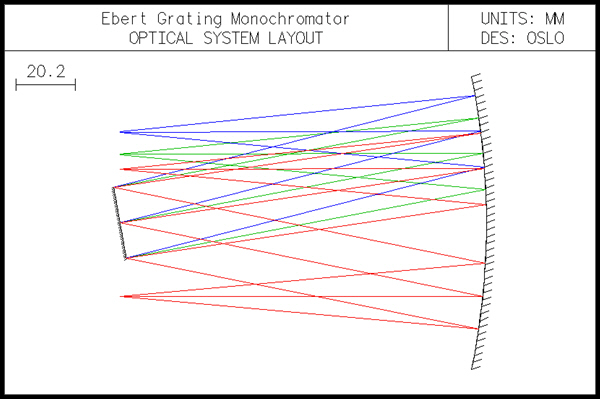EBERT.LEN - A SIMPLE GRATING MONOCHROMATOR
Ebert is a simple grating monochromator that uses a plane grating. It should be studied to understand telecentric systems, rectangular special apertures, off-axis field points as base operating conditions, and the use of diffraction gratings. The Ebert monochromator, also known as the Fastie-Ebert monochromator, since it was developed for practical use by Fastie, is a very simple design that uses a plane grating at or near the focal point of a spherical mirror. The design included in OSLO puts the grating exactly at the focal point, which makes the system telecentric on both object and image sides. The focal points of the overall system are alsin OSLO puts the grating exactly at the focal point,o at infinity, so the system is afocal. Notwithstanding this, the object and image are both at finite distance, and the system is set up as a focal system.

The grating is the aperture stop. This means that the chief ray enters the system parallel to the axis. To accommodate this, the tele general operating condition in OSLO must be turned on. An additional concern caused by the grating being the stop comes from the fact that it is square (the grating used is 25mm square with 600 grooves/mm). This means that the input numerical aperture must be large enough so that the grating is filled, which means that the reported paraxial data does not report the actual performance (see the discussion of apertures).
*LENS DATA Ebert Grating Monochromator
| SRF | RADIUS | THICKNESS | APERTURE RADIUS | GLASS | SPE | NOTE |
| 0 | -- | 125.000000 | 1.0000e-06 | AIR | * | |
| 1 | -250.000000 | -125.000000 | 50.000000 | REFL_HATCH | ||
| 2 | -- | 125.000000 P | 12.500000 AX | REFL_HATCH | * | |
| 3 | -250.000000 P | -125.000000 | 50.000000 P | REFLECT | ||
| 4 | -- | -- | 25.000000 |
The system setup is somewhat unorthodox. The field of view is very narrow, and the object surface is decentered to move the entrance slit off the axis of the spherical mirror. The mirror is tilted using a return_coordinates (rco) command in which the coordinates are returned to the current surface. This has the effect of providing a local coordinate system in which the tilt of the current surfathe coordinates are returned to thece is removed prior to moving to the next surface (cf. the rco commands used in anaprism.len).
*TILT/DECENTER DATA
| 0 | DT | 1 | DCX | -- | DCY | -25.000000 | DCZ | -- |
| TLA | -- | TLB | -- | TLC | -- | |||
| 2 | RCO | 2 | ||||||
| DT | 1 | DCX | -- | DCY | -- | DCZ | -- | |
| TLA | 10.000000 | TLB | -- | TLC | -- |
*SURFACE TAG DATA
| 2 | GOR | -1 | GSP | 0.001667 |
*APERTURES
| SRF | TYPE | APERTURE RADIUS |
| 0 | SPC | 1.0000e-06 |
| 1 | SPC | 50.000000 |
| 2 | SPC | 12.500000 |
Special Aperture Group 0:
| A | ATP | Rectangle | AAC | Transmit | AAN | -- | ||
| AX1 | -12.500000 | AX2 | 12.500000 | AY1 | -12.500000 | AY2 | 12.500000 |
| 3 | PKP | 50.000000 |
| 4 | SPC | 25.000000 |
Another interesting aspect of the Ebert monochromator setup is the default drawing rays, which must be set to fractional coordinates that account for the oversized pupil, and to wavelengths that show the grating dispersion.
*OPERATING CONDITIONS: LENS DRAWING
| Initial distance: | 125.000000 | Final distance: | 125.000000 |
| Horizontal view angle: | 240 | Vertical view angle: | 30 |
| First surface to draw: | 0 | Last surface to draw: | 0 |
| X shift of drawing: | -- | Y shift of drawing: | - |
| Drawn apertures (solid): | Quadrant | Image space rays: | Final dist |
| Rings in aperture (solid): | 3 | Spokes in aperture (solid): | 4 |
| Number of field points (rays): | 3 | DXF/IGES file view: | Unconverted |
| Draw aperture stop location: |
| Fpt | Frac Y Obj | Frac Y Obj | Rays Min Pupil | Max Pupil | Offset | Fan | Wvn |
| 1 | -- | -- | 3 -0.650000 | 0.650000 | -- | Y | 1 |
| 2 | -- | -- | 3 -0.650000 | 0.650000 | -- | Y | 2 |
| 3 | -- | -- | 3 -0.650000 | 0.650000 | -- | Y | 3 |
